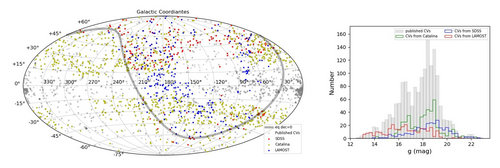Dr. Wen Hou and Prof. Ali Luo from National Astronomical Observatories of Chinese Academy of Sciences (NAOC), together with other researchers, have recently constructed a sample of 245 cataclysmic variables (CVs) from LAMOST DR5. Among this sample, 71 spectra of 58 CVs are firstly discovered, which provide valuable materials for the study of CVs, especially for bright ones. This work has been published in The Astronomical Journal.
CVs are stars which irregularly increase in brightness by a large factor, then drop back down to a quiescent state. They are binary stars that consist of two components, while the two components are so close to each other that the white dwarf primaries accrete matter from low-mass secondaries. The secondaries are usually late main-sequence stars, and in a few cases, they may also be highly evolved stars such as AM CVn type stars. As both variables and binary systems, a further study of the special physical processes of CVs can help us have a better understanding of the structure and the evolution of close binaries.
In order to investigate a comprehensive analysis of CVs in LAMOST survey, the researchers conducted a search of CVs in LAMOST DR5 using the methods of BaggingTopPush and the Random Forest algorithms. Based on the spectral features, finally 245 CVs were found, and 58 among them were newly discovered. Moreover, according to the spectroscopic classification, 134 dwarf novae, 41 nova-like variables, and 19 magnetic CVs are identified from the sample. In addition, 89 high-inclination systems and 33 CVs showing companion stars are recognized and discussed for their distinct spectral characteristics. Investigations of CVs have been carried out based on other large surveys, which include the Sloan Digital Sky Survey (SDSS) and the Catalina Real-time Transient Survey (CRTS). Compared with previous works, our CV sample found in LAMOST DR5 has its own characteristics both in spatial and magnitude distributions. As shown in the following figure, some CVs selected from LAMOST are found at the low galactic latitude, especially in the direction of the Galactic Anticenter. From the perspective of magnitude distribution, CVs from the LAMOST aredistributed in the bright end, about 2 or 3 mag brighter than those from SDSS and CRTS. The construction of the CV sample is our first step, based on which further studies about CVs will be carried out.

Figure. The spatial and magnitude distributions of CVs from LAMOST, SDSS and CRTS surveys.
The link to the paper: https://iopscience.iop.org/article/10.3847/1538-3881/ab5962

Address: 20A Datun Road, Chaoyang District, Beijing, China code: 100012
Tel: 010-64888708 E-mail: naoc@nao.cas.cn

